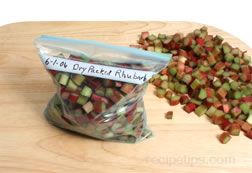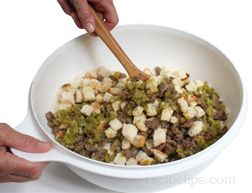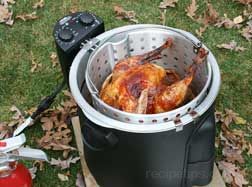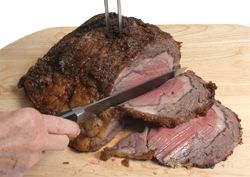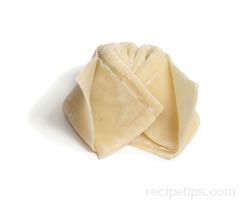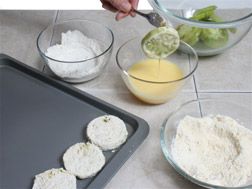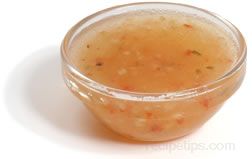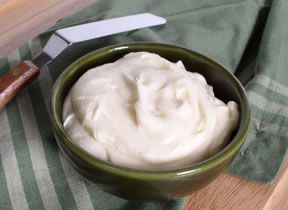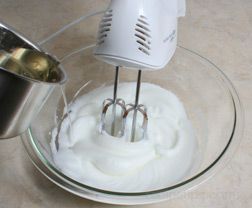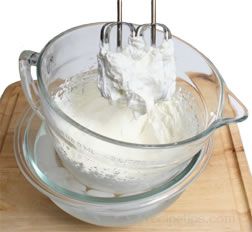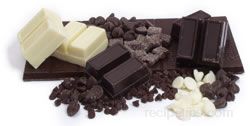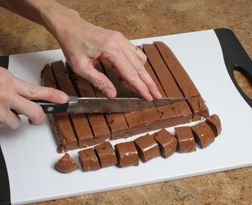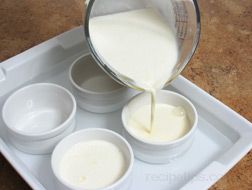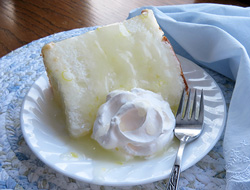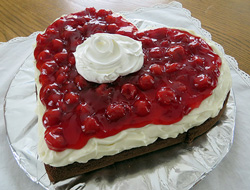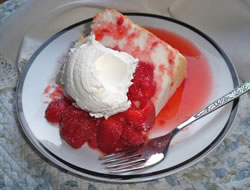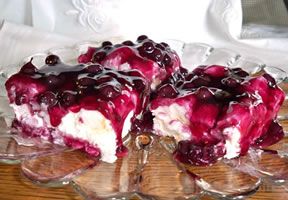|
Storing your food properly and under the best condition possible will extend its life to its maximum potential. Some foods can be stored at room temperature and some must be refrigerated. Freezing can be used to extend the life of many products. To get the most out of the storage areas, certain conditions must be maintained.
Shelf Storage - Shelf storage should be in a cool, dry area. Many food items should also be kept out of direct light. The temperature should be keep at 70° F or below.
Refrigerator Storage - The refrigerator should be kept at a temperature between 33° F to 40° F. Check the temperature frequently with a refrigerator/freezer thermometer.
Freezer Storage - The freezer should be kept at a temperature of 0° F or below. Check the temperature frequently with a refrigerator/freezer thermometer.
Organize Your Storage Area
Organizing your storage areas will give you more room and easier access to the stored food. Having food organized in the refrigerator and freezer will also help save energy by allowing quicker access to the food you are retrieving. The more time that the refrigerator or freezer is open, the more the temperature will drop. This causes the appliance to have to run more to get the temperature back down to what it needs to be, so quick access is important for energy saving. Shown below are some organizing suggestions.
Shelf Storage -
- Use Lazy Susans on shelves that hold small items or where items would be several deep. The Lazy Susan will make access of these items a lot easier.
- Use shallow organizer shelving in tall, deep shelves to add layers for stacking small or shorter items.
- Use wire or plastic baskets to hold odd shaped or bulky items.
- Store opened items, such as pasta, rice and cereals, in clear plastic or glass containers with tight fitting lids to keep them fresh and easily visible. Clear self-sealing bags can also be used.
- If you have a pantry with empty walls, add more shelving or stackable bins.
- When organizing items, place like items together to make it easier to remember where items are store. Store baking ingredients together, canned goods in one area, and dry ingredients in another.
- When adding items to storage, be sure to place newest products in back of what is already on the shelf so that older items get used first.
Refrigerator Storage -
- Keep like items together so you know where to look for them. Have sauces in one area, keep meats in the meat drawer if you have that option available, keep vegetables in the vegetable crispers, and store beverages in the same location.
- Store leftovers in clear containers or bags so you can see what you are searching for without having to open several containers to find it.
- Keep all items as orderly as possible. This will allow more storage space and easier access to the food being stored.
- Remove and discard food that is spoiled or has been stored past the recommended storage time.
Freezer Storage -
- In a refrigerator freezer, keep food stacked as neat as possible by placing the largest flat packages on the bottom. Place other flat packages on top of them with the smallest being at the top. Fit odd size food items in where they best fit. Refrigerator freezers are small and can easily become disorganized, which makes it hard to find the stored item you are searching for.
- Be sure all packages are well marked.
- In large freezer units, organize food into groups of like items. Divide meat into types, such as all beef in one section and pork in another or keep steaks and chops separate from roasts. Food groups can be divided according to your own personal preference.
- Use the freezer baskets to organize smaller items.
- Plastic bags can also be used to organize smaller items. Like items, such as packages of frozen vegetables or individual packages of ground meat, can be put in a bag and placed on top of other items. When they need to be retrieved, the bag can be pulled out and the item accessed. The bag can also be easily removed to allow access to the items below it.
- When adding food to the freezer that is the same as something already stored there, be sure to place it in the same area and under or behind what is already there. This will ensure that the oldest food is used first.
Storage Charts
The chart below shows how long different food items can be stored under different conditions. When freezing food, most can be stored in the freezer longer than suggested below and still be safe to eat but the quality and texture of the food will be affected. Food items that are going to be stored for any period of time should be purchased before the "sell by" or "expiration" date.
Different foods require different preparation methods depending on how it will be stored. Some common preparation methods are shown in the chart below.
|
Storage Chart - Meats (Fresh)
To Refrigerate: Meat should be stored tightly wrapped to prevent it from drying out. Whenever possible, leave the meat wrapped in its original package. If it is necessary to rewrap, wrap tightly in plastic wrap or foil. To Freeze: Remove the meat from the original package and rewrap tightly, using moisture proof heavyweight plastic wrap, foil, freezer bags, or freezer paper. |
| Food Item |
Refrigerator
Storage |
Freezer
Storage |
| Roasts, Beef & Pork |
3 to 5 days |
6 to 12 months |
| Steaks, Beef |
3 to 5 days |
6 to 12 months |
| Chops, Pork & Lamb |
3 to 5 days |
4 to 8 months |
| Ground & Stew Meat |
1 to 2 days |
3 to 4 months |
| Sausage, Pork |
1 to 2 days |
1 to 2 months |
| Variety Meats |
1 to 2 days |
3 to 4 months |
| Meat Substitute - Tofu |
4 to 5 days |
6 to 8 weeks |
|
Storage Chart - Meats (Processed)
To Refrigerate: Meat should be stored in its original package. Once it has been opened, it is necessary to rewrap tightly in plastic wrap or foil. It can also be placed in an airtight bag or container. To Freeze: Leave the meat in the original package and overwrap tightly, using moisture proof heavyweight plastic wrap, foil, freezer bags, or freezer paper. |
| Food Item |
Refrigerator
Storage |
Freezer
Storage |
| Ham, Whole |
7 days |
1 to 2 months |
| Ham, Half or Slices |
3 to 5 days |
1 to 2 months |
| Ham, Canned-Opened |
3 to 5 days |
1 to 2 months |
| Ham, Canned-Unopened |
6 to 9 months |
|
| Bacon |
7 days |
1 to 2 months |
| Frankfurters-Opened |
7 days |
1 to 2 months |
| Frankfurters-Unopened |
14 days |
1 to 2 months |
| Luncheon Meats- Opened |
3 to 5 days |
1 to 2 months |
| Luncheon Meats- Unopened |
14 days |
1 to 2 months |
| Sausage, Smoked |
7 days |
1 to 2 months |
| Sausage, Semi-dry & Dry |
2 to 3 weeks |
1 to 2 months |
| Summer Sausage-Opened |
3 weeks |
1 to 2 months |
| Summer Sausage-Unopened |
3 months |
|
| Pepperoni, Sliced |
2 to 3 weeks |
|
| Corn Beef in Pickling Juice |
5 to 7 days |
1 month |
|
Storage Chart - Meats (Cooked)
To Refrigerate: When refrigerating meat that has been cooked by itself or in a dish with other ingredients, be sure it is stored in a well sealed container so that it does not absorb any odors. If the meat is not combined with other ingredients it can be wrapped tightly in plastic wrap or foil. To Freeze: Prepare the meat or dish in the same manner as for refrigerating, but be sure you use a container or wrap that is freezer safe to protect the food properly. |
| Food Item |
Refrigerator
Storage |
Freezer
Storage |
| Casseroles, Meat & Gravy |
3 to 4 days |
2 to 3 months |
| Soups & Stews |
3 to 4 days |
2 to 3 months |
| Broth |
1 to 2 days |
2 to 3 months |
|
Storage Chart - Poultry (Fresh)
To Refrigerate: If the raw juices are leaking from the original package, it should be removed and the chicken placed in a bowl and covered with wax paper, foil or rewrapped tightly in plastic before placing in the refrigerator. The meat should be stored in the coldest section of the refrigerator. To Freeze: Remove it from the original package and rewrap tightly, using moisture proof heavyweight plastic wrap, foil, freezer bags, or freezer paper. |
| Food Item |
Refrigerator
Storage |
Freezer
Storage |
| Chicken & Turkey, Whole |
1 to 2 days |
1 year |
| Chicken & Turkey, Pieces |
1 to 2 days |
9 months |
| Ground Turkey |
1 to 2 days |
3 to 4 months |
| Giblets |
1 to 2 days |
3 to 4 months |
| Duck & Goose |
1 to 2 days |
6 months |
|
Storage Chart - Poultry (Cooked)
To Refrigerate: When refrigerating poultry meat that has been cooked by itself or in a dish with other ingredients, be sure it is stored in a well sealed container so that it does not absorb any odors. If the meat is not combined with other ingredients it can be wrapped tightly in plastic wrap or foil. To Freeze: Prepare the poultry meat or dish in the same manner as for refrigerating, but be sure you use a container or wrap that is freezer safe to protect the food properly. |
| Food Item |
Refrigerator
Storage |
Freezer
Storage |
| Casseroles, Meat & Gravy |
3 to 4 days |
3 to 6 months |
| Pieces (without Broth) |
3 to 4 days |
2 to 4 months |
| Fried Chicken |
3 to 4 days |
3 to 4 months |
| Chicken Nuggets |
1 to 2 days |
1 to 3 months |
|
Storage Chart - Fish and Shellfish
To Refrigerate: Rinse the fish with cold salt water and pat dry with a paper towel. Wrap it with wax paper or plastic wrap and place it in a self sealing bag. Have a pan of ice ready and place the bag on the bed of ice. Place the pan of ice with the fish in the refrigerator. To Freeze: Clean the fish by rinsing with cold salt water. Place the fish in a double plastic bag or a milk carton and fill it with cold water. Be sure the fish is completely covered and seal the container. Place in the freezer. |
| Food Item |
Refrigerator
Storage |
Freezer
Storage |
| Steaks, fillets, & Shucked Seafood |
1 to 2 days |
3 to 4 months |
| Seafood in the Shell |
1 to 2 days |
3 to 6 months |
| Cooked Fish |
3 to 4 days |
4 to 6 months |
| Smoked Fish |
2 weeks |
2 months |
|
Storage Chart - Vegetables
Storage times are refrigerated times unless otherwise indicated. |
| Food Item |
Preparation Method |
Refrigerator
Storage |
| Commercially Frozen |
Store in original package |
1 year - In Freezer |
Canned Vegetables
(Opened) |
Store in airtight container. Do not store in the opened can. |
3 days |
| Artichokes |
Sprinkle with a little water and place in an airtight plastic bag. |
1 week |
| Asparagus |
Do not wash asparagus before storing. Wash it just before using. To store, wrap in a paper towel and place in a plastic bag that is not airtight, or place upright in a jar or glass containing 1/2 inch of cold water. |
3 to 5 days |
| Beans, Lima |
Beans should be shelled and store in a perforated plastic bag. |
3 to 6 days |
| Beans, Snap |
Leave beans whole and unwashed. Store in a perforated plastic bag in warmest area of the refrigerator. |
3 to 6 days |
| Beets |
Leave roots and trim stems to 1 to 2 inches in length. Brush off dirt but do not wash. Allow to dry in shady area. Place in a plastic bag with a moist paper towel. Check weekly. |
4 to 8 weeks |
| Broccoli |
Store in a perforated plastic bag. |
5 to 7 days |
| Brussel Sprouts |
Trim damaged leaves and store in a perforated bag. |
2 to 3 weeks |
| Cabbage |
Remove any loose leaves from the outer surface and place the cabbage head in a plastic bag. |
4 to 8 weeks |
| Carrots |
Trim tops, leaving 1/2 to 1 inch in length and clean dirt from roots if necessary. Wrap them in a paper towel and place in a plastic bag or place in a perforated plastic bag. |
1 to 3 months |
| Cauliflower |
Do not wash. Place in a perforated plastic bag. |
10 to 14 days |
| Celery |
Wrap a damp paper towel around the celery and then wrap with aluminum foil. |
3 to 4 weeks |
| Corn, Sweet |
Store with husks on |
3 days |
| Cucumber |
Wrap with plastic wrap. |
10 to 12 days |
| Endive |
Wash leaves thoroughly, shake to remove excess moisture, and gather leaves together and tie. Place tied head in a plastic bag. Disgard outer leaves as they wilt but inner leaves will still be good and crisp. |
2 to 3 weeks |
| Fennel |
Store in a plastic bag. |
6 or 7 days |
| Kale |
Remove as much moisture as possible by blotting with a paper towel. Store in a loosely sealed or perforated plastic bag. |
7 to 10 days |
| Kohlrabi |
Trim roots and stems and place in a loosely sealed or perforated plastic bag. |
2 to3 weeks |
| Leeks |
Remove excess moisture by blotting with a paper towel. Place in a plastic bag or wrap with plastic. |
1 to 2 weeks |
| Lettuce, head |
Do not wash before using. Remove the core and outside damaged leaves. Wrap with a damp paper towel and place in a plastic bag. |
10 to 12 days |
| Lettuce, leaf |
Wash leaves and dry in a salad spinner or by shaking off excess water. Layer leaves between paper towels and place in a plastic bag. |
10 to 12 days |
| Mushrooms |
Place in a single layer on a shallow tray or plate. Cover loosely with a damp paper towel or place them in a paper bag, leaving the bag open. |
2 to 3 days |
| Okra |
Store in a plastic bag and place in the warmest area of the refrigerator. |
5 to 7 days |
| Onions |
Be sure onions are dry and then store in a mesh bag or a basket. Storage area must have good air circulation. |
1 to 3 months
(refrigerate or cool, dry area) |
| Parsnips |
Be sure leaves have been trimmed and store parsnips in a perforated plastic bag. |
1 to 2 months |
| Peas |
Store unshelled peas in a perforated plastic bag. Shelled peas can be stored in a regular plastic bag. |
5 to 6 days |
| Peppers |
Do not wash. Wrap in a paper towel or place in a paper bag. Do no use a plastic bag. Store in the vegetable compartment of the refrigerator. |
1 to 2 weeks |
| Potatoes, Sweet |
Place in a well ventilated box or basket and store in a cool (55° to 60° F), moist area with good ventilation. Do not refrigerate. If potatoes are harvested from your garden, they must be cured by setting in a warm, dark place for about one week before storing them. This will help toughen the skins and sweeten the potato. |
2 to 4 months
(do not refrigerate) |
| Potatoes, White |
Place in a well ventilated box or basket and store in a dark, cool (around 40°F works best), moist area with good ventilation. Do not refrigerate and do not store in plastic bags. If potatoes are harvested from your garden, they must be cured by setting in a warm, dark place for about one week before storing them. This will help toughen the skins and store longer. |
2 to 4 months
(do not refrigerate) |
| Radishes |
Trim off leaves and place in a loosely sealed or perforated plastic bag. Wash radishes and trim roots just before using. |
2 to 3 weeks |
| Spinach |
Remove damaged leaves, wash thoroughly with cold water and drain well. Using a salad spinner also works well to dry. Wrap with paper towels and store in a plastic bag. |
2 to 3 days |
| Squash, Summer |
Store in a perforated plastic bag. Do not wash until ready to use. |
1 week |
| Squash, Winter |
Store, whole, in a cool, dry place. Do not wash until ready to use. If cut, store wrapped in plastic and refrigerate for up to 1 week. If whole squash is properly cured in the sun (at 70° to 80° F) for 10 days, it will extend storage time. |
2 to 3 months
(do not refrigerate) |
| Swiss Chard |
Store unwashed in a open or perforated plastic bag. If leaves are damp, pat dry with a paper towel before placing in the plastic bag. |
2 to 4 days |
| Tomatoes, Ripe |
Store with stems down at room temperature. |
5 to 7 days
(do not refrigerate) |
| Tomatoes, Green |
Wrap individually in newspaper and store with stems down at room temperature. Can also be placed in a deep box in 1 or 2 layers, unwrapped. Allow for adaquate air circulation. Avoid exposure to temperatures below 50° F. Check weekly for ripeness. |
2 to 5 weeks
(do not refrigerate) |
| Turnips |
Leave unwashed and trim leaves off. Store in a perforated bag. |
1 to 3 weeks |
|
Storage Chart - Fruit
Storage times are refrigerated times unless otherwise indicated. |
| Food Item |
Preparation Method |
Refrigerator
Storage |
Commerically Frozen
(Unopened) |
Store in original package. |
1 year - In Freezer |
| Canned Fruits (Opened) |
Store in airtight container. Do not store in the opened can. |
3 days |
| Apples |
For best results, place apples in a perforated plastic bag, sprinkle with water and store in the coldest area of the refrigerator. Keep apples away from other fruits and vegetables because they give off a gas called ethylene that speeds up ripening. |
1 to 2 months |
| Avocados |
Store unripened avocados at room temperature. When the fruit feels slightly soft, it is ripe. Ripe avocados can the be stored in the refrigerator. |
2 to3 days
(after ripened) |
| Bananas |
It is best to store bananas at room temperature. They can be refrigerated without damageing the fruit but refrigeration will turn the skins black. |
2 to3 days
(after ripened) |
| Berries |
Do not wash. Refrigerate as soon as possible after picking. Spread out in a thin layer on a tray or plate. Do not cover and place in the refrigerator. Wash gently just before using. |
2 to 3 days |
| Cranberries |
Place in an airtight bag or keep in their original package. Clean just before use. |
3 to 4 weeks |
| Grapefruit |
Can be stored at room temperature but will stay fresh longer if stored in the refrigerator. |
2 to 3 weeks |
| Grapes |
Store in a perforated bag or in a bowl. Extend storage time by placing in a sealed bag and keep in the salad crisper drawer of the refrigerator. |
1 to 2 weeks |
| Kiwi Fruit |
Place ripe fruit in the crisper drawer of the refrigerator. Can store at room temperature for 2 to 3 days |
6 to 8 days |
| Lemons |
Can be stored at room temperature but will stay fresh longer if stored uncovered in the refrigerator. Keep fruit from touching each other. |
2 to 5 weeks |
| Limes |
Place in a plastic bag and store in the refrigerator. |
1 to 3 weeks |
| Melons |
Ripen at room temperature and then refrigerate. Wrap with plastic or place in a plastic bag to keep its smell from affecting other foods stored in the refrigerator. |
6 to 8 days |
| Oranges |
Can be stored at room temperature but will stay fresh longer if stored in the refrigerator. Place in a plastic bag and refrigerate. |
2 to 3 weeks |
| Peaches |
Ripen at room temperature. To speed ripening, place in a loosely closed paper bag. They are ripe when they yield to slight pressure and have a sweet smell. Refrigerate when ripe. |
2 to 3 days |
| Pears |
Ripen at room temperature and then store in coldest part of the refrigerator. |
10 to 14 days |
| Pineapple |
Store at room temperature for 1 to 2 days and then refrigerate. |
3 to 5 days |
| Plums |
Store in the refrigerator |
2 to 3 days |
| Rhubarb |
Cut leaves from stalks and store in a plastic bag or wrapped in plastic. |
1 to 2 weeks |
| Tangerines |
Store in the refrigerator. |
1 week |
| Watermelon |
Uncut watermelon can be stored at room temperature for a few days but cut sections should be wrapped with plastic wrap and refrigerated as soon as possible. |
6 to 8 days |
|
Storage Chart - Convenience Foods
Convenience foods are prepared foods ready to cook or ready to eat without further preparation. |
| Food Item |
Refrigerator
Storage |
Freezer
Storage |
| Prepared Salads (Store Prepared or Homemade) |
3 to 5 days |
Do Not Freeze |
| Deli Stuffed Chicken Breasts or Chops |
1 days |
Do Not Freeze |
| Deli Cooked Meats |
3 to 4 days |
Do Not Freeze |
| Frozen Dinners |
Keep Frozen |
3 to 4 months |
| Vacuum-Packed Dinners (with USDA seal) |
2 weeks |
Do Not Freeze |
|
Storage Chart - Canned and Bottled
The storage times below are the length of time the foods should be stored after they have been opened. |
| Food Item |
Refrigerator
Storage |
Freezer
Storage |
| Baby Food |
1 to 2 days |
Do Not Freeze |
| Fish or Seafood, (such as tuna and salmon) |
2 to 3 days |
Do Not Freeze |
| Meat |
2 days |
Do Not Freeze |
| Gravy or Broth |
2 days |
Do Not Freeze |
| Mayonaise - Commercially Prepared |
2 months |
Do Not Freeze |
| Salad Dressings |
3 months |
Do Not Freeze |
| Ketchup, Mustard, Pickles, & Relishes |
4 to 6 months |
Do Not Freeze |
|
Storage Chart - Dairy and Eggs |
| Food Item |
Refrigerator
Storage |
Freezer
Storage |
| Butter & Margarine |
2 to 3 months |
6 to 8 months |
| Cheese, Fresh |
1 to 2 days |
Do Not Freeze |
| Cheese, Soft |
3 to 4 days |
1 month |
| Cheese, Hard or Semi-hard |
2 to 3 weeks |
3 to 6 months |
| Cheese Spread & Dips |
1 to 2 weeks |
1 month |
| Milk & Cream |
1 week |
3 weeks |
| Ice Cream |
Do not Refrigerate |
1 to 2 months |
| Whipped Topping (Non-Dairy) - Carton |
10 to 14 days |
1 year |
| Yogurt |
1 week |
5 to 6 weeks |
| Eggs in the Shell |
4 to 5 weeks |
Do Not Freeze |
| Eggs, Raw Whites |
2 to 4 days |
6 to 9 months |
| Eggs, Raw Yolks |
2 to 4 days |
3 to 6 months |
| Eggs, Hard Boiled |
1 week |
Do Not Freeze |
| Egg Dish, Cooked |
3 to 4 days |
Do Not Freeze |
|
Storage Chart - Baked Goods
To Refrigerate: Baked goods should be stored tightly wrapped to prevent them from drying out. Wrap tightly in plastic wrap, foil, or in self sealing plastic bags. To Freeze: Freeze baked goods while they are as fresh as possible. Wrap tightly, using moisture proof heavyweight plastic wrap, foil, or freezer bags. |
| Food Item |
Refrigerator
Storage |
Freezer
Storage |
| Bread |
1 week |
3 months |
| Cakes, with Cream Filled, Whipped Topping, or Cream Cheese Frosting |
4 to 5 days |
3 months |
| Pies, Custard |
2 to 3 days |
Do Not Freeze |
| Pies, Fruit |
3 to 4 days |
6 to 8 months |
| Cookie Dough |
4 to 5 days |
2 to 3 months |
| Cookies, Baked |
1 week
(Room Temperature) |
3 months |
| Cookies, Containing Cream Cheese or Cream Frosting |
3 to 5 days |
3 months |
|
Storage Chart - Pantry Items
To Store on the Shelf: All items need to be stored in an airtight container. If the items have not been opened, they can be stored in their original contaners, otherwise a clear, clean container with a airtight cover should be used. A clear container will allow you to see what the container contains. Pantry items should be stored in a dry enviornment, away from direct sunlight. Storage times below are for whether the item is unopened or opened. If there is a difference between unopened and opend, it is indicated. |
| Food Item |
Shelf Storage |
| Baking Powder |
18 months - unopened
6 months - opened |
|
Baking Soda |
2 years - unopened
6 months - opened |
| Biscuit Mix |
12 to 18 months |
| Bread |
3 to 5 days |
| Bread Crumbs |
6 months |
| Brownie Mix |
1 year |
| Cake Mixes |
1 year |
| Candy - Commerically Made |
1 year |
| Canned Fruit and Vegetables |
1 year |
| Cereal |
6 to 12 months - unopened
2 to 3 months - opened |
| Chili Powder |
2 years |
| Chocolate, Semi-sweet |
1 to 2 years |
| Chocolate, Syrup |
2 years
Refrigerate after opening |
| Chocolate, Unsweetened |
18 months |
| Cocoa |
Indefinitely - unopened
1 year - opened |
| Coconut |
1 year - unopened |
| Coffee, Ground |
2 years - unopened
2 weeks - opened |
| Coffee, Instant |
1 year - unopened
2 weeks - opened |
|
Coffee Creamer, Powder |
6 months |
| Cornmeal |
1 year |
| Cornstarch |
18 months |
| Crackers |
6 months |
| Extracts |
6 months |
| Fish, Canned |
12 to 18 months |
| Flour |
6 to 8 months |
| Flour, Self-Rising |
4 to 6 months |
| Formula (Infant) |
12 to 18 months - unopened
2 weeks - opened |
| Gelatin / Pudding |
12 to 18 months |
| Herbs & Spices |
6 to 12 months |
| Honey |
Indefinitely - quality may be affected if over exposed to direct sunlight and/or heat |
| Jams, Jellies, Preserves |
1 Year - unopened
6 months - opened (refrigerated) |
| Juice, Canned-Citrus |
6 months |
| Juice, Canned-Noncitrus |
1 year |
| Marshmallow Creme |
4 months |
| Marshmallows |
3 months |
| Mayonnaise, commercial |
4 months - unopened, on shelf
2 months - opened, refrigerated |
| Meats & Poultry, Canned |
12 to 18 months |
| Milk, Canned |
1 year |
| Milk, Nonfat Dry |
6 months |
| Molasses |
1 year - unopened
6 months - opened |
| Nuts |
8 months |
| Olives |
1 year |
| Pancake Mixes |
6 months |
| Paprika |
8 months |
| Pasta / Noodles, Dried |
2 years |
| Peanut Butter |
6 to 9 months |
| Peppers, Canned or Pickled |
1 year |
| Pickles |
1 year |
| Popcorn, Unpopped |
1 to 2 years |
| Potatoes, Instant |
18 months |
| Rice, White |
2 years |
| Salad Dressing |
10 months - unopened
3 months - opened, refrigerated |
| Salt |
Store Indefinitely |
| Sauces, Condiments, Relishes |
1 year - unopened |
| Shortening |
8 months - unopened
6 months - opened |
| Sodas |
3 months - unopened |
| Stuffing Mix |
6 months |
| Sugar, Brown |
4 months |
| Sugar, Confectioners |
18 months |
| Sugar, Granulated |
2 years |
| Sugar, Substitutes |
2 to 3 years |
| Syrups |
1 year |
| Tea, Bags |
18 months |
| Tea, Instant |
3 years |
| Tea, Loose |
2 years |
| Tomato Sauce or Paste |
12 to 18 months |
| Vinegar - Do not store in a metal container. Store in its original container or in a glass container. |
Store Indefinitely | |






